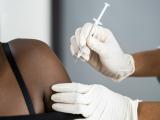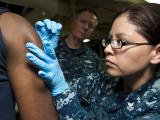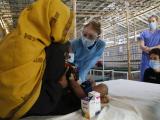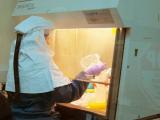Aug 30, 2011 (CIDRAP News) – Early diagnosis and treatment were crucial in helping a Florida man beat the odds by recovering from inhalational anthrax, a rare and often deadly disease, according to a Minneapolis physician who treated him.
The patient, Dan Anders, 61, of St. Petersburg, Fla., was released from Hennepin County Medical Center (HCMC) in Minneapolis yesterday after more than 3 weeks of hospitalization, the Minneapolis Star Tribune reported today. He had somehow contracted the disease during a 3-week vacation in Montana, Wyoming, and the Dakotas, and was sick when he arrived in Minnesota near the end of the trip.
"I think a key part of his survival was that he was diagnosed reasonably early . . . and got started on the right therapy. If that hadn't happened it wouldn't have been good," Dr. Mark Sprenkle of the Division of Pulmonary and Critical Care Medicine at HCMC told CIDRAP News. He also said the use of anthrax immune globulin supplied by the Centers for Disease Control and Prevention (CDC) may have contributed to Anders' recovery.
The Minnesota Department of Health (MDH) first reported the anthrax case on Aug 9, but the patient remained unnamed until today's newspaper story. MDH officials believe Anders contracted anthrax through exposure to Bacillus anthracis spores in the soil in one of the states he visited. The FBI investigated the case initially but concluded there was no evidence of bioterrorism.
Anders was feeling "overtired" when he and his wife arrived in Pelican Rapids, Minn., on Aug 3 to visit friends, according to the Star Tribune. By the next day he was very sick and was hospitalized in Fergus Falls, Minn., where he was treated for pneumonia.
A doctor there was alarmed by the appearance of his lung x-ray and ordered a lab test, which showed an unusual Bacillus strain, the story said. The doctor then sent a sample to the MDH, which confirmed the presence of B anthracis.
Minnesota State Epidemiologist Dr. Ruth Lynfield said the Fergus Falls hospital staff deserves credit for acting quickly in the case, according to the Star Tribune. "They knew what they were doing, and they put the picture together," she said.
Anders was transferred to HCMC by air ambulance on Aug 7. When he arrived he was awake and conversant and receiving supplemental oxygen, but his condition deteriorated within a few hours, and he was soon transferred to the intensive care unit (ICU), according to Sprenkle. "By the time he was in the ICU he had pretty severe hypoxia and respiratory distress and was put on a ventilator," he said.
Doctors in Fergus Falls had initially treated Anders with antibiotics for bacteria commonly seen in community-acquired pneumonia, but once the anthrax diagnosis came through, they switched to drugs recommended for that disease, Sprenkle said. At HCMC the patient was initially treated with ciprofloxacin and clindamycin, he said.
On his second day at HCMC, Anders also was treated with anthrax immune globulin provided by the CDC, a product derived from the serum of people who have received the anthrax vaccine, Sprenkle reported. "It's antibodies that can be administered to people who have active infection, to bind up the [anthrax] toxin and mitigate the disease," he said.
By the time the patient was hospitalized at HCMC, his blood cultures were already negative for B anthracis, but the toxin produced by the bacterium remains after the infection itself subsides, Sprenkle noted.
Sprenkle said Anders was only the 19th person to receive the human-derived anthrax immune globulin, which he said wasn't available in 2001 when 22 people contracted anthrax infections after envelopes containing spores were mailed to media outlets and two US senators. The immune globulin was used more recently to treat some patients in an outbreak of cutaneous anthrax in Scotland, he said.
A supply of human-derived anthrax immune globulin is held in the Strategic National Stockpile of drugs and medical supplies, CDC officials said today, but the amount of the supply is kept secret for security reasons. The product was used successfully to treat an inhalational anthrax patient under an emergency protocol in 2006, according to a 2007 report in Clinical Infectious Diseases.
Another part of Anders' treatment was to drain a buildup of pleural fluid from around his lungs, with the aim of reducing the load of anthrax toxin in his body, Sprenkle said. Fluid around his right lung was drained on his first day in the hospital, and the other side was drained the next day.
Sprenkle said it is difficult to pinpoint when Anders reached a turning point, but he commented, "I think after 7 days I began to feel more confident he was going to be able to get through things." Anders remained on the ventilator for 10 to 14 days, however.
The mortality rate for inhalational anthrax is typically listed at 80% to 90%, but that is based largely on old data, such as an outbreak in Russia in 1979, Sprenkle noted. Mortality in inhalational cases in the 2001 anthrax attacks was more like 45%, he said.
In any case, the risk was very serious for Anders, Sprenkle said, "but there were a lot of things that helped him. He was diagnosed reasonably early, he was put on the right antibiotics reasonably early, and we did the pleural drainage and he received immune globulin."
Anders will need to continue taking oral ciprofloxacin for several more weeks, in line with CDC recommendation for 60 days of treatment in such cases, Sprenkle said. He said his patient may have some lingering effects for a few weeks or longer, but predicted he will recover fully in time.
See also:
April 2008 Emerg Infect Dis report on public health and clinical guidelines for anthrax
April 2007 Clin Infect Dis report on anthrax case with immune globulin treatment



















